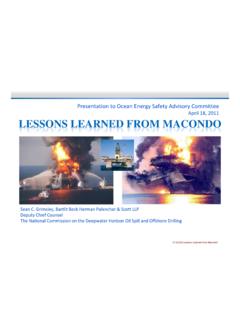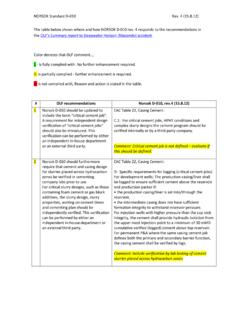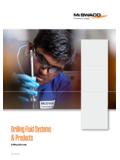Transcription of An Introduction to Coiled Tubing
1 PresentsHistory, Applications, and BenefitsICoTA MissionTo enhance communication, gather technical expertise and promote safety, trainingcompetency and industry accepted practices within the Coiled Tubing Introduction to Coiled is CT?.. 1 Key Elements of a CT Unit .. 1 Well Control 3CT 4CT Field 4 History .. 5CT 5 Early CT 5 Evolution of CT 5 The 9 Growth of the CT Service Fleet .. 9 New CT Markets/Field 10CT Service 10 The 11 Raw Material for CT .. 11CT 11CT Mechanical 12CT String Design .. 13CT Inspection Tools .. 14 Repairs and 14 Addressing Offshore Weight and Space 15 Extending the CT Operating Envelope Downhole Tractors .. 15 Alternatives to Carbon Steel & Completion Applications .. 17 Common CT Workover 17 Removing Sand or Fill from a Wellbore.
2 17 Unloading a Well with a Applications .. 19 Non-Directional 19 Directional 19 Wellbore Hydraulics and Drilling 20 Overbalanced 20 Underbalanced 21 Pipeline 22 Overcoming Pipeline Drag 23 Permanent 24 Offshore 24 Velocity 25 Control 25 Nomenclature .. 262005 ICoTA Board Members .. 27 Membership 28 The ICoTA website contains a wealth of additional Coiled Tubing information,including technical papers, the latest meeting notices, visit our website at: Coiled Tubing AssociationWhat is CT? Coiled Tubing (CT) has been defined as any continuously-milled tubular product manufactured inlengths that require spooling onto a take-up reel, during the primary milling or manufacturingprocess. The tube is nominally straightened prior to being inserted into the wellbore and is recoiledfor spooling back onto the reel.
3 Tubing diameter normally ranges from in. to 4 in., and singlereel Tubing lengths in excess of 30,000 ft. have been commercially manufactured. Common CTsteels have yield strengths ranging from 55,000 PSI to 120,000 ELEMENTS OF A CT UNITThe Coiled Tubing unit is comprised of the complete set of equipment necessary to perform standardcontinuous-length Tubing operations in the field. The unit consists of four basic elements:`Reel - for storage and transport of the CT`Injector Head - to provide the surface drive force to run and retrieve the CT`Control Cabin - from which the equipment operator monitors and controls the CT`Power Pack - to generate hydraulic and pneumatic power required to operate the CT unitFigure 1: Trailer Mounted CT Unit and CraneControlCabinTubingReelCoiledTubingI njectorHeadPowerPack1 International Coiled Tubing AssociationDetailed Photos of CT Unit Key Elements Figure 2: Injector Head Figure 4: Control CabinFigure 3: ReelFigure 5.
4 Power Pack2 International Coiled Tubing AssociationWELL CONTROL EQUIPMENTP roper well control equipment is another key component of CT operations, given that a majority ofthese operations are performed in the presence of surface wellhead pressure. Typical CT wellcontrol equipment consists of a BOP topped with a stripper (high pressure CT units have twostrippers and additional BOP components). All components must be rated for the maximumwellhead pressure and temperature possible for the planned field stripper (sometimes referred to as a packoff or stuffing box) provides the primary operationalseal between pressurized wellbore fluids and the surface environment. It is physically locatedbetween the BOP and the injector head.
5 The stripper provides a dynamic seal around the CTduring tripping and a static seal around the CT when there is no movement. The latest style ofstripper devices are designed with a side door, that permits easy access and replacement of thesealing elements, with the CT in BOP is situated beneath the stripper, and can also be used to contain wellbore pressure. ACT BOP is designed specifically for CT operations. It consists of several pairs of rams, with eachram designed to perform a specific function. The number and type of ram pairs in a BOP aredetermined by the BOP configuration: single, double, or quad. A quad system is commonly usedin most four BOP rams, from top to bottom and their associated functions are:`Blind ram - seals the wellbore when the CT is out of the BOP`Shear ram - used to cut the CT`Slip ram - supports the CT weight hanging below it (some are bi-directional andprevent the CT from moving upward)`Pipe ram - seals around the hanging CTStandard CT BOPs also contain two equalizing ports, one on each side of the sealing rams.
6 Italso has a side outlet between the slip and shear rams. This outlet can be used as a safety killline. BOPs are available in a range of sizes, and normally follow the API flange Coiled Tubing AssociationTraditional Applications`Well Unloading`Cleanouts`Acidizing/Stimulatio n`Velocity Strings`Fishing`Tool Conveyance`Well Logging (real-time & memory)`Setting/Retrieving PlugsGrowth Applications`CT Drilling`Fracturing`Subsea`Deeper Wells`Pipeline/FlowlineCT BENEFITSW hile the initial development of Coiled Tubing was spurred by the desire to work on live wellbores,speed and economy have emerged as key advantages for application of CT. In addition, therelatively small footprint and short rig-up time make CT even more attractive for drilling and of the key benefits associated with the use of CT technology are as follows:`Safe and efficient live well intervention`Rapid mobilization and rig-up`Ability to circulate while RIH/POOH`Reduced trip time, resulting in less production downtime`Reduced crew/personnel requirements`Cost may be significantly reducedCoiled Tubing can also be fitted with internal electrical conductors or hydraulic conduits, whichenables downhole communication and power functions to be established between the BHA andsurface.
7 In addition, modern CT strings provide sufficient rigidity and strength to be pushed/pulledthrough highly deviated or horizontal wellbores. This enables successful execution of downholeoperations that would be impossible to perform with conventional wireline approaches, or wouldbe cost prohibitive if performed by FIELD APPLICATIONSThe use of CT has continued to grow beyond the typical well cleanout and acid stimulationapplication. This growth can be attributed to a multitude of factors, including advances in CTtechnology and materials as well as the increased emphasis on wellbores containing a horizontaland/or highly-deviated CT application list (below) is provided as a "thought-provoker", to illustrate additional operationswhere CT could be of benefit in your future field Coiled Tubing AssociationHistoryThe development of Coiled Tubing as we know it today dates back to the early 1960's, and it hasbecome an integral component of many well service and workover applications.
8 While well service/workover applications still account for more than 75% of CT use, technical advancements haveincreased the utilization of CT in both drilling and completion ability to perform remedial work on a live well was the key driver associated with the developmentof CT. To accomplish this feat, three technical challenges had to be overcome:`A continuous conduit capable of being inserted into the wellbore (CT string).`A means of running and retrieving the CT string into or out of the wellbore whileunder pressure (injector head).`A device capable of providing a dynamic seal around the Tubing string(stripper or packoff device).CT ORIGINP rior to the Allied invasion in 1944, British engineers developed and produced very long, continuouspipelines for transporting fuel from England to the European Continent to supply the Allied project was named operation "PLUTO", an acronym for "Pipe Lines Under The Ocean", andinvolved the fabrication and laying of several pipelines across the English Channel.
9 The successfulfabrication and spooling of continuous flexible pipeline provided the foundation for additional technicaldevelopments that eventually led to the Tubing strings used today by the CT 1962, the California Oil Company and Bowen Tools developed the first fully functional CT unit,for the purpose of washing out sand bridges in CT EQUIPMENTThe first injector heads operated on the principle of two vertical, contra-rotating chains. Thisdesign is still used in the majority of CT units today. The stripper was a simple, annular-typesealing device that could be hydraulically activated to seal around the Tubing at relatively low wellheadpressures. The Tubing string used for the initial trials was fabricated by butt-welding 50 ft.
10 Sectionsof 1 3/8 in. OD pipe into a 15,000 ft. string and spooling it onto a reel with a 9 ft. diameter OF CT EQUIPMENTT hroughout the late 1960's and into the 1970's, both Bowen Tools and Brown Oil Tools continuedto improve their designs to accommodate CT up to 1 in. OD. By the mid-1970's, more than 200 ofthe original-design CT units were in service. By the late 1970's, several new equipmentmanufacturing companies (Uni-Flex Inc., Otis Engineering, and Hydra Rig Inc.) also startedinfluencing improved injector head Coiled Tubing AssociationFigure 6: Modern CT Equipment on a Land LocationCT strings were also undergoing significant improvements during this period. Through the late1960's, CT services were dominated by Tubing sizes of 1 in.






